
Health 'Insurance' at Sea: 1 2 3 4 5 6 7 8 9 10 11 12 13 Next>>
Health 'Insurance' at Sea During the Golden Age of Piracy, Page 12
Long-Term Health Care - Navy's Chatham Chest Pension Payments
Pension payments were the key to the Chatham Chest, although information about how payments were given to pensioners before 1675 are difficult to find. One of the earliest notes on payments comes from historian John Keevil. He explains that during the First Dutch War, the Sick and Hurt Board administered pensions, "assessing disabilities and awarding gratuities [one time payments] up to £10, or pensions up to £6, 13s.4d. a year. Cases in excess of these sums were to be referred to the Admiralty Committee."1 The last sum is interesting in that it is seen again in later payment schedules for the loss of a limb.
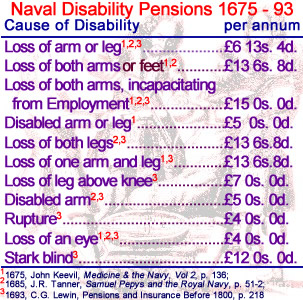
Naval Disability Pension Schedule - 1675, 1685, 1693
Image:
Amputation From Lorenz Heister's "A General System
of Surgery" (1743)
Each historian researching the schedules of payment for pensioners found different documents describing the payment process, which appear in the chart at left. While the standard injuries for which pensions were awarded vary between the three sources, the payments themselves are entirely consistent.2
Each author cites a different source for the information found in their book. The first source (indicated by a superscripted 1 in the chart) is from historian John Keevil's book, which dates to 1675-1693.3 It is titled Payments to Pensioners, and referenced as ADM 82/12 in The National Archives in Kew, Richmond, England. The second source (indicated by a superscripted 2) is from historian John Robson Tanner's book Samuel Pepys and the Royal Navy4, which he describes as being a "paper of 24 July, 1685"5. The third source (indicated by a superscripted 3) is from C.G. Lewin's Pensions and Insurance Before 1800 and is taken from two sources - ADM 82/12 (the one cited by Keevil) and a list found in the Calendar of Treasury Books.6
It is entirely possible that these payments, like the payment of 6 pence per month into the Chatham Chest, remained constant over time. When presenting his list of pension payments, Lewin explains that a description of the Chest operation from 1693 advises that the payments "'depend chiefly on a long and uninterrupted custom and prescription' and can therefore safely be assumed to have worked in much the same way since the Chest was founded."7 It is also possible that this information ultimately comes from a single source.
The above list does not encompass all the wounds for which sailors received pensions; a variety of 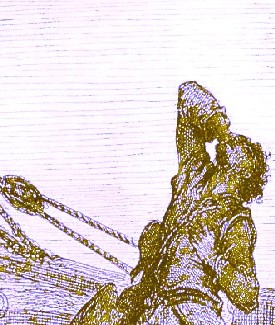
Artist: Gustav Dore
From The Rime of the Ancient Mariner (1866)
non-standard injuries were also awarded pensions on a case-by-case basis. John Keevil notes,
The loss of a right thumb was assessed at £5, a disabled right hand at £6; a man with 'both arms much disabled' received £10 a year, as did one whose legs were affected. There was flexibility too in the awards for blindness, which ranged from £6, 13s. 4d. to £12. Other entries are: 'vertebrae of back disordered', £7; rupture, £4; 'thigh fractured with large wound’, £6; 'hands and face much burnt', £6, or if ‘extremely burnt', £8; 'left hand & thigh wounds', £5; knee fractured, £4, 'left eye lost & hand disabled', £5; lower jaw 'Torne in Sunder', £8; right leg and left foot 'Extreamely Burnt with Powder', £12 right arm disabled and 'large wound in belly' £12.8
Note that several of the wounds and amounts Keevil describes in the above list were treated as standard pension items in the lists provided by Tanner and Lewin, again suggesting a possible common source for all the information presented in the above chart.
Although the chest was supposed to be for the payment of annual pensions, one-time payments were sometimes made as well. During the wars of the latter half of the 18th century, some wounds were not considered to be worthy of an annual pension but still deserving of payment. Tanner's 1685 document from the Pepsys collection explained that
where any wound or hurt occasions a fracture, contusion, impostumation, or the like, under the loss of a limb, such are viewed by the chirurgeons, and certified to deserve what in their opinions may be a proportionable reward in full satisfaction. And these sorts of hurts frequently accompany the loss of a limb in other parts of the body, for which they have a reward apart from their annual allowance, according to the chirurgeon's discretion.9
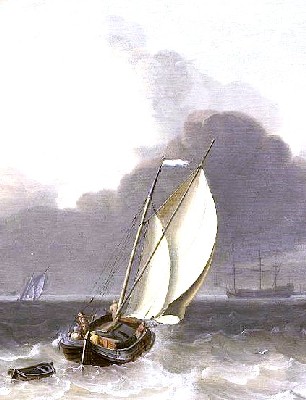
Artist: Jan Claesz Rietschoof
Davey's Boat Was Probably Much Smaller Than This
Spritsail
Barge, Perhaps More Like the Jolly Boat (17th-18th c.)
Keevil explains that 'non-pensionable' wounds "such as bruises, simple fractures or abscesses... were assessed by the Surgeon-General or his deputies for a [one-time] 'reward'"10. He further explains that during peace-time "all disabilities were placed in this group, the men receiving a single payment of 'hurt money paid in full satisfaction'"11.
This included one-time payments of £20 for a 'left hand utterly disabled', £2 for loss of sight in one eye, £6 for a sailor 'much impaired in his strength', a variety of bruises paid at £1 to up to £10 (when 'severe and extensive') as well as "various shot wounds ....assessed at £3, 10s. to £8, no explanation being offered for their occurrence in peace."12 Perhaps the most interesting reason for a one-time payment was in 1639, "when £5 was given to Thomas Davey, pensioner, to buy him a boat to earn his living."13
When a pension was awarded to a sailor, the first payment was made "at once as 'present relief' and then renewed annually."14 This up-front payment was called 'smart money' by the seamen15, which hearkens back to the plans created by merchant companies. Although pensions were awarded for life, men receiving them had to appear before the Council every three years. This was not to reapply for a pension, rather "to avoid pensions being drawn by relatives after a man's death."16 However, this policy had changed over time; in the 1640s pensioners who lived around London were required to appear in Chatham "with the aim of reducing or suspending their pension if they had partially recovered."17
Some changes were made to the Chatham Chest pension plan over time. We have already seen
that the Commission paid lump sums from the 'Extra Chest' to buy pensions after the Spanish
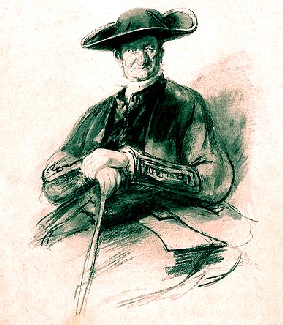
Artist: F.C. Lewis after D. Wilkie
A Naval Pensioner, (1826)
War as a cost saving effort in 1661. This practice appears to have continued in a limited fashion. In 1684, two year's worth of pension were used to buy off certain men's pensions.
But this buying off of pensions is not practised to those who have lost a leg or an arm excepting only in the case of Scotch or Irish or others who live beyond the seas, who upon their earnest entreaty and in consideration of the charge they would be exposed to in appearing personally at a general pay of the Chest (which all pensioners are obliged to do once in three years) have their pension bought off as aforesaid18.
In 1673, the Council expanded some of the coverage of the Chest. It now provided a year's pay without a pension and pay as long as they were under cure to "sea officers for the loss of an eye or limb or who hold a certificate from the Surgeon General"19. A few months later, this was also extended to volunteers. A few months after that it was decided that even when a wound was not of the severity of the loss of an eye, "‘the party wounded may be continued during the time of his cure in the pay he enjoyed at the time of his being wounded" as well as expenses, provided the cure was certified by "'his doctor, nurse, apothecary, and chirurgeon respectively' and if considered reasonable by [Superintendant of Hospitals John] Knight and [Surgeon General of the Navy James] Pearse."20 However, the majority of money was directed to wounded and disabled regular Navy sailors.
1 John J. Keevil, Medicine and the Navy 1200-1900: Volume II – 1640-1714, p. 21; 2 I must admit to not having found access to any of the original sources cited, so I am relying on the information presented by the modern historians; 3 See Search results for ADM 82/12, The National Archives website, gathered 3/17/16; 4 Footnoted by Tanner As Coming From Samuel Pepys, A Miscellany of Matters Historical, Political, and Naval, vol. vi, p. 71; 5 J.R. Tanner, Samuel Pepys and the Royal Navy, 1920, p. 51-2; 6 Lewin cites the Calendar of Treasury Books 1681-85, page 1482, January 7, 1684-5; 7 C.G. Lewin, Pensions and Insurance Before 1800 A Social History, 2003, p. 218; 8 Keevil, p. 136; 9 Tanner, p. 52; 10,11 Keevil, p. 137; 13 Lewin, p. 222; 14 Keevil, p. 136; 15 Lewin, p. 218; 16 Keevil, p. 136-7; 17 Lewin, p. 222; 18 Lewin, p. 231; 19 Keevil, p. 134; 20 Keevil, p. 135
Long-Term Health Care - The Navy's Greenwich Hospital
At the beginning of William's War in 1689, interest began to build for a pensioner's hospital,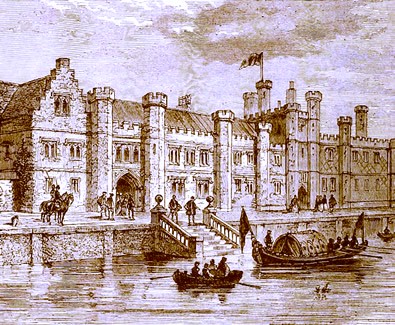
Palace at Placentia in 1630, From Old and New London, Vol VI, p. 174 (1899)
one dedicated to "taking custodial care of those permanently disabled in a national conflict"1. The partially ruined Palace of Placentia on the Thames at Greenwich was examined and the Sick and Hurt Commission was requested to estimate the cost of converting it into a hospital. Queen Mary II immediately gave her consent to having part of the Palace converted, so a Corporation of Trinity House was formed and a caretaker selected. Work began in the winter.2
Following the Action at La Hogue in May of 1692, the queen was so moved by the lack of beds for the wounded that she extended her grant to include the entire palace and its gardens. However, as the battles in William's War moved to the Mediterranean and the West Indies, the landed sick and wounded decreased and the project ceased to be urgent. With the increase in building size, they also became more complicated, requiring extra planning and taking more time to complete. The queen never saw the completed hospital, dying from smallpox in December of 1694. However, her death "proved a more effective stimulus than had all her past endeavours: the rapid completion of the hospital [renovation] was due to the king's wish that it should commemorate her."3
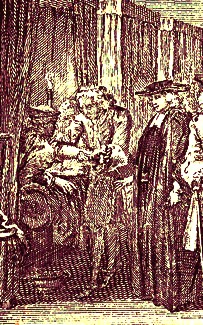
Artist: Richard Grey
The County Infirmary at Northampton
From the Wellcome Collection (1744)
John Evelyn became involved in the building of the Greenwich Hospital in 1694, recording on February 17th that he was "Called to London by Lord Godolphin, one of the Lords of the Treasury, offering me the treasurership of the hospital designed to be built at Greenwich for worn-out seamen."4 Evelyn created an endowment fund, promising an annual grant of £2000 from the privy purse. A public appeal was made for subscriptions, although money came in slowly.5
King Edward commissioned the hospital on March 2, 1695, although the first patient wasn't received into the hospital for another 10 years; William died in 1702 and so never saw the hospital actually in operation. The next phase of construction began in 1696 when additional buildings designed by Christopher Wren began to rise.
To help pay for the new buildings, all sailors in England "whether serving in the Royal Navy or the merchant marine, were required to pay sixpence per month out of their wages, for the upkeep of the newly founded Greenwich Hospital" as of Lady Day (March 25), 1696.6 In addition to being a contribution to their hospital, it was to be "a form of insurance for the rating [enlisted men in the navy]."7 The Admiralty also decided in 1698 that all fines imposed at courts-martial were to be given to the new foundation, effectively channeling all the money which had previously been paid to the Chatham Chest to support the new hospital. Although disabled pirates had no claim on the beds at the hospital, one did help to indirectly finance it; the proceeds from the liquidation of William Kidd's estates were given to the fund after he was hanged in 1705.8
The pirates weren't the only ones who didn't get to use the services of the pensioner's hospital. Historian Ed Fox points out that the hospital "nominally was founded for the relief of all [legitamate] seamen, but in practice was limited to supporting those injured in the service of the crown which, while it might include men serving in merchant ships hired by the government, largely precluded merchant seamen from reaping the benefits of their monthly contribution unless they later served in the Royal Navy and were injured."9
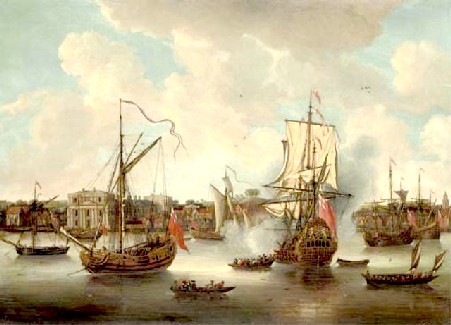
Artist: Isaac Sailmaker - A flagship arriving at Greenwich Hospital (17th/18th c.)
As the buildings were completed the first physician for the hospital, a Dr. Cade, was appointed to the in 1703 and the first surgeon in 1704. The first pensioner was admitted to the hospital in March, 1705, with the result that "both the accommodation and the scheme of insurance were thus too late to benefit the veterans of [William's War which ended in] 1697."10 Even so, the available beds quickly filled.11
Within a few years of its opening, Greenwich became the center of Naval medicine.12 Naval surgeons kept two journals of their surgical exploits at sea and at the end of their voyage, one of the journals was to given to the Barber Surgeon's Company and the other was presented to the physician at Greenwich.13 In April of 1715, the inspection of the naval surgeon's medicine chests was transferred from Barber Surgeon's Hall to Dr. William Oliver and Mr. lsaac Rider at Greenwich Hospital.14 "Greenwich, with its splendid buildings naval quality, attracted to it a loyalty which [the Barber Surgeon's Company at] Monkwell Street had never been able to command from its naval foreign brothers."15
1 Harold J Cook, "Practical Medicine and the British Armed Forces After the 'Glorious Revolution," Medical History, p. 7; 2 John J. Keevil, Medicine and the Navy 1200-1900: Volume II – 1640-1714, p. 199; 3 Keevil, p. 199; 4 The Diary of John Eveylyn, edited by Austin Dobson, Volume III, 1906, p. 314; 5 Keevil, p. 201; 6 Ed Fox, Doctoral Thesis, 'Piratical Schemes and Contracts': Pirate Articles and Their Society, 1660-1730, University of Exeter, May 2013, p. 175 & Keevil, p. 201; 7 Keevil, p. 201; 8 Peter Kemp, The British Sailor: a Social History of the Lower Deck. 1970. p. 64. 9 Fox, p. 175-6; 10 Keevil, p. 202; 11 Fox, p. 176; 12 Keevil, p. 264; 13 Keevil, p. 259; 13 Keevil, p. 255; 15 Keevil, p. 264-5

